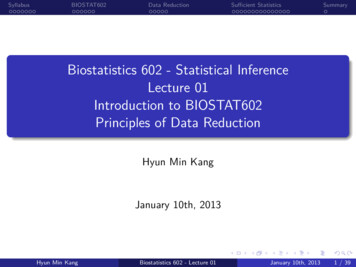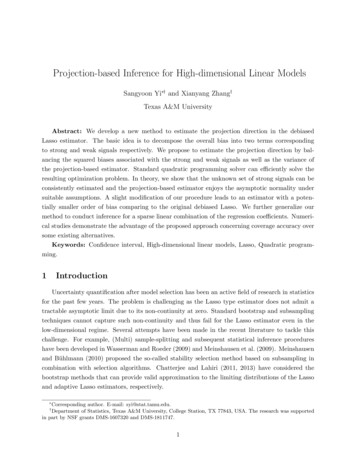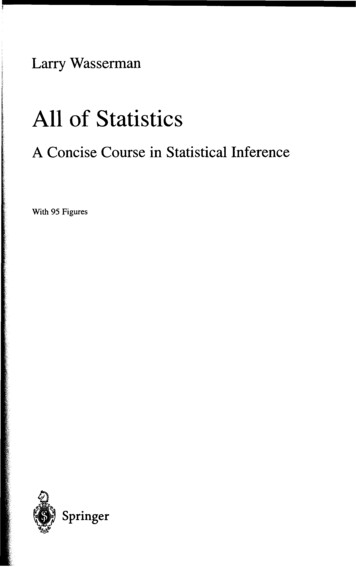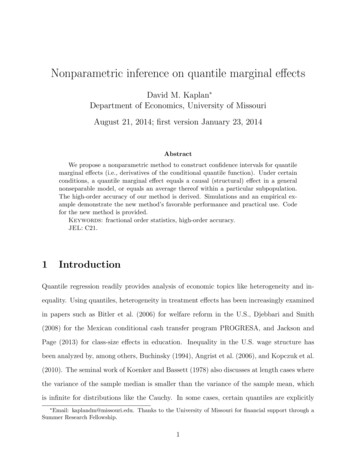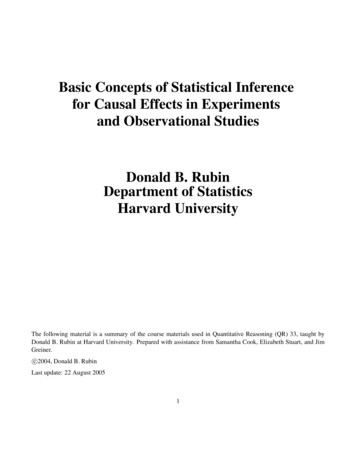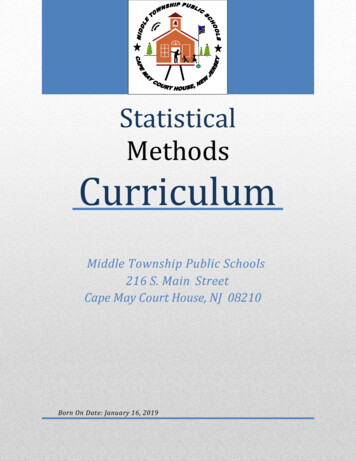
Transcription
Statistical InferenceAn Integrated ApproachSecond Edition
CHAPMAN & HALL/CRCTexts in Statistical Science SeriesSeries EditorsFrancesca Dominici, Harvard School of Public Health, USAJulian J. Faraway, University of Bath, UKMartin Tanner, Northwestern University, USAJim Zidek, University of British Columbia, CanadaStatistical Theory: A Concise IntroductionF. Abramovich and Y. RitovPractical Multivariate Analysis, Fifth EditionA. Afifi, S. May, and V.A. ClarkModelling Survival Data in Medical Research,Second EditionD. CollettPractical Statistics for Medical ResearchD.G. AltmanIntroduction to Statistical Methods forClinical TrialsT.D. Cook and D.L. DeMetsIntroduction to Probability with RK. BaclawskiMultivariate Survival Analysis and CompetingRisksM. CrowderInterpreting Data: A First Coursein StatisticsA.J.B. AndersonApplied Statistics: Principles and ExamplesD.R. Cox and E.J. SnellLinear Algebra and Matrix Analysis forStatisticsS. Banerjee and A. RoyStatistical Analysis of Reliability DataM.J. Crowder, A.C. Kimber,T.J. Sweeting, and R.L. SmithStatistical Methods for SPC and TQMD. BissellIntroduction to ProbabilityJ. K. Blitzstein and J. HwangBayesian Methods for Data Analysis,Third EditionB.P. Carlin and T.A. LouisSecond EditionR. CaulcuttThe Analysis of Time Series: An Introduction,Sixth EditionC. ChatfieldIntroduction to Multivariate AnalysisC. Chatfield and A.J. CollinsProblem Solving: A Statistician’s Guide,Second EditionC. ChatfieldStatistics for Technology: A Course in AppliedStatistics, Third EditionC. ChatfieldBayesian Ideas and Data Analysis: AnIntroduction for Scientists and StatisticiansR. Christensen, W. Johnson, A. Branscum,and T.E. HansonModelling Binary Data, Second EditionD. CollettAn Introduction to GeneralizedLinear Models, Third EditionA.J. Dobson and A.G. BarnettNonlinear Time Series: Theory, Methods, andApplications with R ExamplesR. Douc, E. Moulines, and D.S. StofferIntroduction to Optimization Methods andTheir Applications in StatisticsB.S. EverittExtending the Linear Model with R:Generalized Linear, Mixed Effects andNonparametric Regression ModelsJ.J. FarawayLinear Models with R, Second EditionJ.J. FarawayA Course in Large Sample TheoryT.S. FergusonMultivariate Statistics: A PracticalApproachB. Flury and H. RiedwylReadings in Decision AnalysisS. FrenchMarkov Chain Monte Carlo:Stochastic Simulation for Bayesian Inference,Second EditionD. Gamerman and H.F. Lopes
Bayesian Data Analysis, Third EditionA. Gelman, J.B. Carlin, H.S. Stern, D.B. Dunson,A. Vehtari, and D.B. RubinMultivariate Analysis of Variance andRepeated Measures: A Practical Approach forBehavioural ScientistsD.J. Hand and C.C. TaylorPractical Data Analysis for Designed PracticalLongitudinal Data AnalysisD.J. Hand and M. CrowderLogistic Regression ModelsJ.M. HilbeRichly Parameterized Linear Models:Additive, Time Series, and Spatial ModelsUsing Random EffectsJ.S. HodgesStatistics for EpidemiologyN.P. JewellStochastic Processes: An Introduction,Second EditionP.W. Jones and P. SmithThe Theory of Linear ModelsB. JørgensenPrinciples of UncertaintyJ.B. KadaneGraphics for Statistics and Data Analysis with RK.J. KeenMathematical StatisticsK. KnightIntroduction to Multivariate Analysis:Linear and Nonlinear ModelingS. KonishiNonparametric Methods in Statistics with SASApplicationsO. KorostelevaModeling and Analysis of Stochastic Systems,Second EditionV.G. KulkarniExercises and Solutions in Biostatistical TheoryL.L. Kupper, B.H. Neelon, and S.M. O’BrienExercises and Solutions in Statistical TheoryL.L. Kupper, B.H. Neelon, and S.M. O’BrienDesign and Analysis of Experiments with SASJ. LawsonA Course in Categorical Data AnalysisT. LeonardStatistics for AccountantsS. LetchfordIntroduction to the Theory of StatisticalInferenceH. Liero and S. ZwanzigStatistical Theory, Fourth EditionB.W. LindgrenStationary Stochastic Processes: Theory andApplicationsG. LindgrenThe BUGS Book: A Practical Introduction toBayesian AnalysisD. Lunn, C. Jackson, N. Best, A. Thomas, andD. SpiegelhalterIntroduction to General and GeneralizedLinear ModelsH. Madsen and P. ThyregodTime Series AnalysisH. MadsenPólya Urn ModelsH. MahmoudRandomization, Bootstrap and Monte CarloMethods in Biology, Third EditionB.F.J. ManlyIntroduction to Randomized ControlledClinical Trials, Second EditionJ.N.S. MatthewsStatistical Methods in Agriculture andExperimental Biology, Second EditionR. Mead, R.N. Curnow, and A.M. HastedStatistics in Engineering: A Practical ApproachA.V. MetcalfeStatistical Inference: An Integrated Approach,Second EditionH. S. Migon, D. Gamerman, andF. LouzadaBeyond ANOVA: Basics of Applied StatisticsR.G. Miller, Jr.A Primer on Linear ModelsJ.F. MonahanApplied Stochastic Modelling, Second EditionB.J.T. MorganElements of SimulationB.J.T. MorganProbability: Methods and MeasurementA. O’HaganIntroduction to Statistical Limit TheoryA.M. Polansky
Applied Bayesian Forecasting and Time SeriesAnalysisA. Pole, M. West, and J. HarrisonStatistics in Research and Development,Time Series: Modeling, Computation, andInferenceR. Prado and M. WestIntroduction to Statistical Process ControlP. QiuSampling Methodologies with ApplicationsP.S.R.S. RaoA First Course in Linear Model TheoryN. Ravishanker and D.K. DeyEssential Statistics, Fourth EditionD.A.G. ReesStochastic Modeling and MathematicalStatistics: A Text for Statisticians andQuantitativeF.J. SamaniegoStatistical Methods for Spatial Data AnalysisO. Schabenberger and C.A. GotwayBayesian Networks: With Examples in RM. Scutari and J.-B. DenisLarge Sample Methods in StatisticsP.K. Sen and J. da Motta SingerDecision Analysis: A Bayesian ApproachJ.Q. SmithAnalysis of Failure and Survival DataP. J. SmithApplied Statistics: Handbook of GENSTATAnalysesE.J. Snell and H. SimpsonApplied Nonparametric Statistical Methods,Fourth EditionP. Sprent and N.C. SmeetonData Driven Statistical MethodsP. SprentGeneralized Linear Mixed Models:Modern Concepts, Methods and ApplicationsW. W. StroupSurvival Analysis Using S: Analysis ofTime-to-Event DataM. Tableman and J.S. KimApplied Categorical and Count Data AnalysisW. Tang, H. He, and X.M. TuElementary Applications of Probability Theory,Second EditionH.C. TuckwellIntroduction to Statistical Inference and ItsApplications with RM.W. TrossetUnderstanding Advanced Statistical MethodsP.H. Westfall and K.S.S. HenningStatistical Process Control: Theory andPractice, Third EditionG.B. Wetherill and D.W. BrownGeneralized Additive Models:An Introduction with RS. WoodEpidemiology: Study Design andData Analysis, Third EditionM. WoodwardExperimentsB.S. Yandell
Texts in Statistical ScienceStatistical InferenceAn Integrated ApproachSecond EditionHelio S. MigonDani GamermanFrancisco Louzada
CRC PressTaylor & Francis Group6000 Broken Sound Parkway NW, Suite 300Boca Raton, FL 33487-2742 2015 by Taylor & Francis Group, LLCCRC Press is an imprint of Taylor & Francis Group, an Informa businessNo claim to original U.S. Government worksVersion Date: 20140520International Standard Book Number-13: 978-1-4398-7882-8 (eBook - PDF)This book contains information obtained from authentic and highly regarded sources. Reasonable effortshave been made to publish reliable data and information, but the author and publisher cannot assumeresponsibility for the validity of all materials or the consequences of their use. The authors and publishershave attempted to trace the copyright holders of all material reproduced in this publication and apologize tocopyright holders if permission to publish in this form has not been obtained. If any copyright material hasnot been acknowledged please write and let us know so we may rectify in any future reprint.Except as permitted under U.S. Copyright Law, no part of this book may be reprinted, reproduced, transmitted, or utilized in any form by any electronic, mechanical, or other means, now known or hereafter invented,including photocopying, microfilming, and recording, or in any information storage or retrieval system,without written permission from the publishers.For permission to photocopy or use material electronically from this work, please access www.copyright.com (http://www.copyright.com/) or contact the Copyright Clearance Center, Inc. (CCC), 222 RosewoodDrive, Danvers, MA 01923, 978-750-8400. CCC is a not-for-profit organization that provides licenses andregistration for a variety of users. For organizations that have been granted a photocopy license by the CCC,a separate system of payment has been arranged.Trademark Notice: Product or corporate names may be trademarks or registered trademarks, and are usedonly for identification and explanation without intent to infringe.Visit the Taylor & Francis Web site athttp://www.taylorandfrancis.comand the CRC Press Web site athttp://www.crcpress.com
To Mirna, our sons and grandchildren (H.S.M.)To Bernardo (i.m.) and Violeta (D.G.)To Gleici, Lucas, Caio, Samuel and Francisco (F.L.)
This page intentionally left blank
ContentsPreface to the Second EditionxiiiPreface to the First Editionxv1 Introduction1.1 Information1.2 The concept of probability1.3 Assessing subjective probabilities1.4 An example1.5 Linear algebra and probability1.5.1 Probability theory1.5.2 Linear algebra1.6 Notation1.7 Outline of the bookExercises123671212151617192 Elements of inference2.1 Common statistical models2.2 Likelihood-based functions2.2.1 Likelihood function2.2.2 Fisher information2.3 Bayes theorem2.3.1 Prediction2.3.2 Sequential nature of the Bayes theorem2.4 Exchangeability2.5 Sufficiency and exponential family2.6 Parameter elimination2.6.1 Bayesian approach2.6.2 Classical approachExercises2121232427313235374147475155ix
xCONTENTS3 Prior distribution3.1 Entirely subjective specification3.1.1 Aspects on elicitation of expert beliefs3.2 Specification through functional forms3.3 Conjugacy with the exponential family3.3.1 Binomial distribution3.3.2 Normal distribution with known variance3.3.3 Poisson distribution3.3.4 Exponential distribution3.3.5 Multinomial distribution3.3.6 Normal distribution with known mean and unknownvariance3.3.7 Normal distribution with unknown mean and variance3.4 Non-informative priors3.4.1 Jeffreys non-informative priors3.4.2 Reference priors3.5 Hierarchical priorsExercises4 Estimation4.1 Introduction to decision theory4.1.1 Classical decision theory4.1.2 Bayesian decision theory4.1.3 Statistical inference as a decision problem4.2 Bayesian point estimation4.3 Classical point estimation4.3.1 Maximum likelihood4.3.2 Method of least squares4.3.3 Method of moments4.3.4 Empirical distribution function4.4 Empirical Bayes estimation4.5 Comparison of estimators4.5.1 Bias4.5.2 Risk4.5.3 Consistency4.6 Interval estimation4.6.1 Bayesian approach4.6.2 Classical approach4.6.3 Bonferroni 9142
CONTENTS4.7Estimation in the Normal model4.7.1 One sample case4.7.2 Two samples caseExercisesxi1421421481545 Approximating methods5.1 The general problem of inference5.2 Optimization techniques5.2.1 Solution of the likelihood equation5.2.2 The EM Algorithm5.2.3 Determining likelihood intervals5.3 Asymptotic theory5.3.1 Towards asymptotic confidence intervals5.3.2 The delta method5.3.3 First order asymptotics5.3.4 Higher order asymptotics5.4 Other analytical approximations5.4.1 Approximation by Kullback-Liebler divergence5.4.2 Laplace approximation5.5 Numerical integration methods5.5.1 Newton-Cotes type methods5.5.2 Gauss-Hermite rules5.6 Simulation methods5.6.1 Monte Carlo method5.6.2 Monte Carlo with importance sampling5.6.3 Resampling methods5.6.3.1 Jackknife5.6.3.2 Bootstrap5.6.3.3 Weighted bootstrap5.6.4 Markov chain Monte Carlo 851851871891901911931931961992002022042052136 Hypothesis testing6.1 Introduction6.2 Classical hypothesis testing6.2.1 Simple hypotheses6.2.2 Composite hypotheses6.2.3 Hypothesis testing with the Normal distribution6.3 Bayesian hypothesis testing6.3.1 Bayesian testing alternatives221221222223227232236242
xiiCONTENTS6.4 Hypothesis testing and confidence intervals6.5 Asymptotic testsExercises2462502557 Prediction7.1 Bayesian prediction7.2 Classical prediction7.3 Prediction in the Normal model7.3.1 Bayesian approach7.3.2 Classical approach7.4 Linear predictionExercises2632642682712712732742778 Introduction to linear models8.1 The linear model8.2 Classical estimation of linear models8.3 Bayesian estimation of linear models8.4 Hierarchical linear models8.5 Dynamic linear models8.5.1 Definition and examples8.5.2 Evolution and updating equations8.5.3 Special aspects8.5.4 Hyperparameter estimation8.6 Linear models with 309314Sketched solutions to selected exercises319List of distributions331References337Index343
Preface to the Second EditionIt has been more than a decade since the 1st edition was released. Over thisperiod the need for a more balanced account of the main schools of thoughtto statistical inference became clear. The main purpose of the book has always been a balanced and integrated presentation of these approaches to thesubject. But the first edition was written only by the first two authors of thisedition; both were assumedly Bayesian and mentioned that in the Preface forthat edition.Experience gathered in the meantime indicated to us some ingredients toget back to our original goal. Certainly a more detailed and comprehensivepresentation of the pros and cons of each approach had to be pursued. Theinclusion of a co-author who was more involved with the frequentist schoolwas also recommended to achieve a more balanced presentation. We werefortunate to add both ingredients and present the current version of our workafter these additions.We have tried to eliminate (or reduce, more realistically) the typos presentin the 1st edition. Additionally, we have included more explanation, more illustration and more exercises for the concepts already present here. Moreimportantly, new material has been included. The main novelties are associated with a new section on empirical Bayes and penalized likelihoods and theirimpact on the regression models in the last chapter. Interestingly, these aretopics that lie closer to the border between the two schools of thought. Thecontent of this new material has also been connected to many other parts ofthe book, throughout its chapters. Additionally, we have expanded material inmany sections, specially on hypothesis testing, method of moments and biascorrection.This has been an interesting journey for the authors that is far from over.Statistics is alive and growing as a discipline with an ever increasing impactof the growth in computational power. We have no illusion of having reacheda complete and final text on the subject, but hope to have reached a stagewhere readers can grasp the main task ahead of them in their search for anintegrated understanding of Statistical Inference.xiii
xivPREFACE TO THE SECOND EDITIONThere are a number of people that we would like to thank and show ourgratitude. We all thank our common friend Luis Raul Pericchi for the suggestion of the 3rd author name and many other suggestions. Thanks are alsodue to our lifelong friend Basilio Pereira for much and relentless advice withreferences and perspective. There is no way to avoid acknowledging the fundamental help of Rob Calver. He has been keen on making this project viablesince the release of the 1st edition. There were many many moments that hewas the only one believing it. His persistence and enthusiasm was crucial tohave us reached this stage. He is complemented by a number of competentcolleagues at CRC who have helped us in many different ways. We also thankcolleagues and students who have helped shape the work in various ways, andour families for their encouragement and support. To all of them, our sincerest gratitude. We hold none of them responsible and take full account for theviews expressed in this book.H.S.M., D.G. and F.L.Rio de Janeiro and São Carlos, May 2014
Preface to the First EditionThis book originated from the lecture notes of a course in Statistical Inferencetaught at the M.Sc. programs in Statistics at UFRJ and IMPA (once). Thesehave been used since 1987. During this period, various modifications have beenintroduced until we arrived at this version, judged as minimally presentable.The motivation to prepare this book came from two different sources.The first and more obvious one for us was the lack of texts in Portuguese,dealing with statistical inference to the desired depth. This motivation led usto prepare the first draft of this book in the Portuguese language in 1993.The second, and perhaps the most attractive as a personal challenge, was theperspective adopted in this text. Although there are various good books in theliterature dealing with this subject, in none of them could we find an integratedpresentation of the two main schools of statistical thought: the frequentist (orclassical) and the Bayesian. This second motivation led to the preparationof this English version. This version has substantial changes with respect tothe Portuguese version of 1993. The most notable one is the inclusion of awhole new chapter dealing with approximation and computationally intensivemethods.Generally, statistical books follow their author’s point of view, presenting at most, and in separate sections, related results from the alternativeapproaches. In this book, our proposal was to show, wherever possible, theparallels existing between the results given by both methodologies. Comparative Statistical Inference by V. D. Barnett (1973) is the book that is closestto this proposal. It does not, however, present many of the basic inference results that should be included in a text proposing a wide study of the subject.Also we wanted to be as comprehensive as possible for our aim of writing atextbook in statistical inference.This book is organized as follows. The first chapter is an introduction, presenting the readers with the way we find most appropriate to think of Statistics: discussing the concept of information. Chapter 2 presents some basicconcepts of statistics such as sufficiency, exponential family, Fisher information, permutability and likelihood functions. Another basic concept specificxv
xviPREFACE TO THE FIRST EDITIONto Bayesian inference is prior distribution; that is separately dealt with inChapter 3.Certain aspects of inference are individually presented in Chapters 4, 6, and7. Chapter 4 deals with parameter estimation where, intentionally, point andinterval estimation are presented as responses to the summarization question,and not as two unrelated procedures. The important results for the Normaldistribution are presented and also serve an illustrative purpose. Chapter 6 isabout hypotheses testing problems under the frequentist approach and alsounder the various possible forms of the Bayesian paradigm.In between them, lies Chapter 5 where all approximation and computationally based results are gathered. The reader will find there at least a shortdescription of the main tools used to approximately solve the relevant statistical problem for situations where an explicit analytic solution is not available.For this reason, asymptotic theory is also included in this chapter.Chapter 7 covers prediction from both the frequentist and Bayesian pointsof view, and includes the linear Bayes method. Finally in Chapter 8, an introduction to Normal linear models is made. Initially the frequentist approachis presented, followed by the Bayesian one. Based upon the latter approach,generalizations are presented leading to the hierarchical and dynamic models.We would like to alert the readers from the onset that the our preferredpoint of view is the Bayesian one. So, a natural emphasis is given to thisapproach. We tried, however, to develop a critical analysis and to present themost important results of both approaches commenting on the positive andnegative aspects of both. As it has already been said, the level of this bookis adequate for an M.Sc. course in Statistics, although we do not rule out thepossibility of its use in an advanced undergraduate course aiming to comparethe two approaches.This book can also be useful for the more mathematically trained professionals from related areas of Science such as Economics, Mathematics, Engineering, Operations Research and Epidemiology. The basic requirements areknowledge of calculus and probability, although basic notions of linear algebraare also used. As this book is intended as a basic text in statistical inference,various exercises are included at the end of each chapter. We have also included sketched solutions to some of the exercises and a list of distributionsat the end of the book, for easy reference.There are many possible uses of this book as a textbook. The first andmost obvious one is to present all the material in the order it appears inthe book and without skipping sections. This may be a heavy workload for aone-semester course. In this case we suggest dropping Chapter 8 for a later
PREFACE TO THE FIRST EDITIONxviicourse. A second option for exclusion in a first course is Chapter 5, althoughwe strongly recommend it for anybody interested in the modern approach tostatistics, geared towards applications. The book can also be used as a text fora course that is more strongly oriented towards one of the schools of thought.For a Bayesian route, follow Chapters 1, 2, 3, Sections 4.1, 4.4.1 and 4.5,Chapter 5, Sections 6.3, 6.4, 6.5, 7.1, 7.3.1, 7.4, 8.1, 8.3, 8.4 and 8.5. For aclassical route, follow Chapter 1, Sections 2.1, 2.2, 2.5, 2.6, 4.2, 4.3, 4.4.2 and4.5, Chapter 5, Sections 6.1, 6.2, 6.4, 6.5, 7.2, 7.3.2, 7.4, 8.1 and 8.2.This book would not have been possible without the cooperation of variouspeople. An initial and very important impulse was the typing of the originallecture notes in TeX by Ricardo Sandes Ehlers. Further help was providedby Ana Beatriz Soares Monteiro, Carolina Gomes, Eliane Amiune Camargo,Monica Magnanini and Otávio Santos Figueiredo. Besides these, many of ourformer students helped with suggestions and criticism. Careful proofreading ofthis manuscript was made by our past M.Sc. students and present colleaguesAlexandra Mello Schmidt, Hedibert Freitas Lopes and Marco Antonio RosaFerreira. Many useful suggestions and comments were provided at this laterstage by Steve Brooks, Eduardo Gutierrez-Peña and Gabriel Huerta. We alsohad the stimulus of several colleagues; in particular, we would like to mentionBası́lio de B. Pereira. I would also like to thank Nicki Dennis for her supportand encouragement throughout all the stages of preparation of this book andfor making us feel at home with Arnold. Our families also played the importantroles of support and understanding, especially in the weekends and late nightsspent trying to meet deadlines! To all of them, our gratitude.Finally, the subject of the book is not new and we are not claiming anyoriginality here. We would like to think that we are presenting the subject ina way that is not favored in many textbooks and that will help the readersto have an integrated view of the subject. In our path to achieve this goal,we have had the influence of many researchers and books. We have triedto acknowledge this influence by referring to these books whenever we feltit provided a worthwhile reading description of a topic. Therefore, for everymajor subject presented in our book we tried to relate it to books that treatedthe subject in a more complete or more interesting way. In line with a textbookcharacter, we opted to favor books rather than research papers as references.We would like to think of our book as a basis for discovery and will feelour task is acomplished whenever readers understand the subject through thebook alone, its references or a combination of both.H.S.M. & D.G.Rio de Janeiro, December 1998
This page intentionally left blank
Chapter 1IntroductionBefore beginning the study of Statistics, it is relevant to characterize the scopeof the area and the main issues involved in this study. We avoid directly defining the subject, which is a hard and polemical task. Some of the componentsinvolved in this area of science will be presented in the hope that at the endthe reader will have a clear notion of the broadness of the subject under consideration. The fundamental problem towards which the study of Statistics isaddressed is that where randomness is present. The statistical methodology todeal with the resulting uncertainty is based on the elaboration of probabilisticmodels in order to summarize the relevant information available.There are many concepts used in the last sentence that deserve a clarifiedexplanation of their meaning in order to ensure a unified understanding. Amodel is a formal collection of coherent rules describing, in a simplified way,some real world problem. The language used to describe precisely a model inwhich uncertainty is present is probability. The meaning of summarization, inthis context, refers to the ability to describe a problem in the most conciseway (under the assumption that there are many possible forms to describe aproblem). The art involved in model building is the desire to balance the needto include as many aspects of reality as possible while keeping it not very complex. A related concept, which is useful to have in mind, is that of parsimony.This means that the model must have an appropriate level of complexity. Avery simple model can be misleading since it is eventually missing relevantaspects of the reality. On the other hand, if the model is highly complex itwill be hard to understand and extract meaningful information from it. Fromthe previous discussion it is not difficult to guess that information is the maininput for Statistics. However, this is a hard concept to define.Among the objectives of our study, we can identify the two main onesas being to understand reality (estimation and hypothesis testing) and tomake a decision (prediction). A strong limitation of many presentations of1
2INTRODUCTIONstatistical inference is being mainly concentrated in estimation and testing. Inthis context, it only deals with quantities that can never be observed in thepresent or in the future. Nevertheless, our view of Statistics is that it mustbe concerned with observable quantities. In this way, one is able to verify themodel adequacy in an irrefutable way. For the sake of completeness, however,we will present the main results available from all of the topics above.1.1InformationAs we have already said, the notion of information is present in all the studiesdeveloped in Statistics. As far as uncertainty is one of the main ingredientsin our models, we need to gather as much information as possible in order toreduce our initial uncertainty. A fundamental question which we are concernedwith is about the type of information that is relevant and must be retained inthe analysis. A possible reply to this question is that all available informationis useful and must be taken in consideration. Another answer is to avoidarbitrariness and take in consideration only objective observation coming froma sampling process. For this all the subjective information must be discarded.These two points of view roughly form the bases for two different forms ofstatistical analysis: the Bayesian (or subjectivist) and the classical (or frequentist) approaches, respectively. As we will see in the next section the divergenceamong these two approaches is much stronger, beginning with the interpretation of the concept of probability. This is always the starting point of astatistical model.An example to illustrate and clarify these points follows.Example 1.1 Consider the situation described in Berger (1985) concerningthe following experiments:1. A fine musician, specialized in classical plays, tell us that he is able todistinguish if Hayden or Mozart composed some classical song. Smallexcerpts of the compositions of both authors are selected at randomand the experiment consists of playing them for identification by themusician. The musician makes 10 correct guesses in exactly 10 trials.2. A drunk man says that he can correctly guess in a coin toss whatface of the coin will fall down. Again, after 10 trials the drunk mancorrectly guesses the outcomes of the 10 throws.3. An old English lady is well known for her ability to distinguish whethera cup of tea is prepared by first pouring the milk or the tea. Thencups filled with tea and milk, well mixed and in a random order, arepresented to her. She correctly identifies all ten cups.
THE CONCEPT OF PROBABILITY3It is not difficult to see that the three experiments provide the same information, and therefore, any test to verify the authenticity of the person’sstatement would result positive for all of them, with the same confidence.This does not make any sense! We have more reason to believe in the authenticity of the statement of the musician than of the old lady and, certainly,much more than of the drunk man. There is no doubt that the experimentaloutcome increases the veracity of the statements made. But we cannot reasonably say that we have the same confidence in the three assertions. By commonsense, there is a long way to go before one accepts this conclusion.1.2The concept of probabilityAlthough the definition of probability is well accepted by almost every statistician (keeping away some technical details), its interpretation or the senseattributed to it varies considerably. We mention here some of the more common interpretations: physical (or classical), frequentist and subjective.Physical or classicalThe probability of any event is the ratio between the number of favorableoutcomes and the total number of possible experimental results. It is implicitlyassumed that all the elem
Elementary Applications of Probability eory, Second Edition H.C. Tuckwell Introduction to Statistical Inference and Its Applications with R M.W. Trosset Understanding Advanced Statistical Methods P.H. Westfall and K.S.S. Henning Statistical Process Control: eory and Practice, ird Edition G.B. Wetherill and D.W. Brown Generalized Additive Models:
